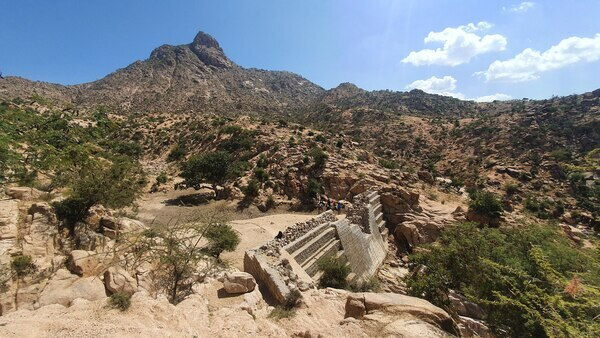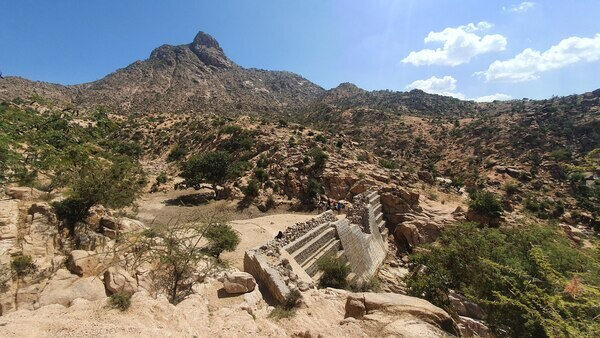
Development cooperation in the pandemic year 2020
Dear friends,
It has been almost a year since our last newsletter. A lot has happened in the world during this time; it is no longer the same as it was a year ago. Eritrea has not been spared from the COVID-19 pandemic either, on the contrary. In addition, East Africa was attacked this year by a plague of locusts. Many farmers lost their field crops and thus also the seeds for next year. And just over three weeks ago, an armed conflict broke out in Eritrea’s neighbouring country Ethiopia, which is already leaving first traces in Eritrea and threatens to plunge the entire region of the Horn of Africa into unrest. We will report more on the current situation in Eritrea in a separate newsletter.
Despite all these circumstances, our project lives on and has been able to take small steps forward in the past months. This is where the mutual trust built up over the years with our local partner, the Water Resource Department, pays off. A project trip to Eritrea had to be postponed for an indefinite period until the local situation and the situation in Europe improve.

The sand storage dam at the end of 2019
At the end of 2019’s rainy season, the sand storage dam almost reached the final height of impressive seven meters on the wing walls, and the steps in the middle overflow were built up to almost four meters in height. The last stage of the overflow was completed after last year’s last major rain event, so that the next construction activities were planned for the rainy season in summer 2020 – as soon as the storage volume behind the last stage is completely filled with coarse sediments. The aim until then was to improve the quality of the sand reservoir through desiltation and levelling measures. The step height, which was in some cases a little too high, and the dam upstream, which last year was not completely filled, led to unwanted deposits of fine sediments (silt) in the storage volume of our dam. During the project trip in autumn 2019, we agreed with our local partners and the village population, who provides the majority of the workforce, to remove the unwanted fine sediments. The village population agreed to carry out the time-consuming, arduous work as a personal contribution.
While Eritrea imposed a national lockdown in the spring of this year and almost completely prevented entry into the country, the villagers were nevertheless able to independently advance the project without explicit supervision or assignment by the civil engineers. The result is impressive: Several cubic meters of fine sediments were removed and the storage volume with initial height difference of up to two meters was evenly levelled. These measures significantly increased the quality of the sand reservoir and prepared the structure for the coming rainy seasons.

Desiltation work on the sand reservoir 2020
The close cooperation with the Water Resource Department and the strong involvement of the Begu population through workshops, numerous discussions, and the friendships that developed between all project participants over the years enabled us to maintain and continue the project even in times of pandemic. The decisive factors for a functioning dam are clear from the villagers to the Water Resource Department to the project team in Germany and all of our supporters. We are all pulling together and everyone involved takes ownership of the project!
The desiltation work was ended in good time before the start of this year’s rainy season. This year´s rain events were able to fill up the storage volume, while the village population checked the quality of the accumulated sediments between each rain event and, if necessary, carried out smaller desiltation activities.
As the video clip shows, the construction progress of recent years can even be followed on Google Earth via satellite images. You can see the dam wall rising just above the river bend on the left down corner in the picture, where a small inflow grows from above onto the main river bed, which runs diagonally from top right to bottom left. With each wall stage built, the storage volume is visibly filled with sediments and grows continuously. In the coming year we will be able to build more stages and get closer to the completion of the dam!
While our Eritrean friends continued to work hard on site, we did not take a break in Germany either. We received a grant of around EUR 2,500 from the Hamburg University of Technology and continue counting on the friendly support of the Rotary Club Norderstedt with another contribution of EUR 2,500. As a contribution to an international WASH conference for Eritrea by UNICEF scheduled for this year, we published a scientific article about the project. In addition, Springer journal Wasserwirtschaft publishes a report on our project in its December issue. Here, the project principle is explained and challenges and possible solutions highlighted. Last but not least, we are pleased to introduce our new Instagram account waterforeritrea, through which we continuously deliver updates and news with many visual impressions about the project and the country. Follow us on Instagram!
You will continue to hear from us in the next few weeks. As already announced, we would like to report in more detail on the current situation in Eritrea that is hit hard by pandemic, plagues and war. Also, there is a Christmas surprise coming!
And for everyone who would like to support us financially, betterplace.org increases by 10% every donation up to € 200 on the Advent Sundays – a nice campaign 🙂
Bye for now,
Your project team “Water for Eritrea”
Text: marius.koenig
